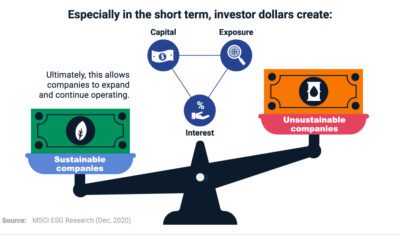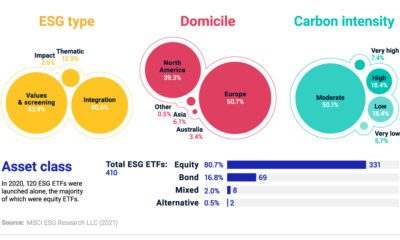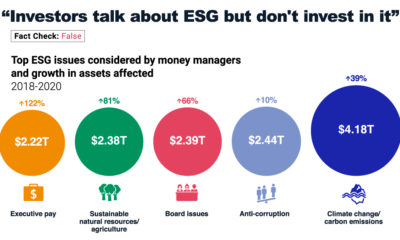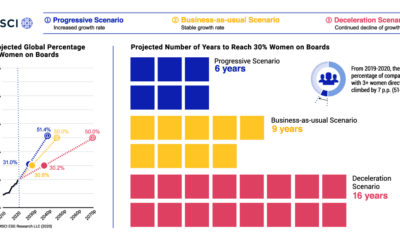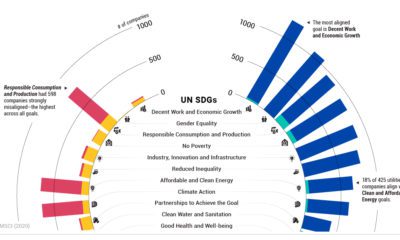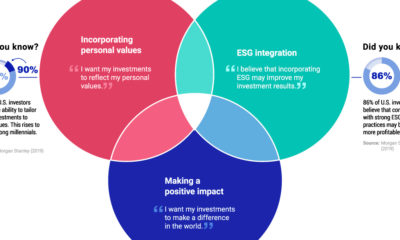Back then, the internet was anticipated to radically reshape economies. Many companies fell to the wayside, and now 20 years later, tech stocks currently make up roughly 40% of the S&P 500 by market capitalization. Like the dot-com era, green firms are projected to structurally change the way businesses function. Given the rising interest in green assets, this infographic from MSCI answers the most important questions advisers need answered on sustainable investing.
1. Which type of sustainable investing is right for my client?
First, let’s start with the basics—understanding the terms used to describe sustainable investing:
Sustainable investing: An umbrella term that typically refers to all types of sustainable, impact, and environmental, social, and governance (ESG) integration approaches Impact investing: A type of investing approach that generates measurable social or environmental benefits Socially responsible investing (SRI): An investing approach that aligns with an investor’s ethical, religious, or personal values, while actively reducing negative environmental or social consequences ESG integration: Considers material environmental, social, and governance factors to enhance long-term risk adjusted returns through its investment approach Climate investing: Looks to reduce exposure to climate risk, identify low-carbon investment opportunities, or align portfolios with “net-zero” climate targets
Knowing the key terms of the sustainable landscape allows advisers to more accurately address client objectives, goals, and beliefs.
2. How can I start a conversation with clients about ESG?
Begin by asking what motivates clients. Typically, motivations fall into one of three core objectives:
Can ESG factors improve my risk-adjusted returns? Can I have a positive impact on society through my investments? Are my investments consistent with my ethical, political, or religious beliefs?
Client priorities could include financial returns, impact, values, or a combination. Once these have been established, investors can choose from a universe of funds and investment vehicles that more strongly align with their goals.
3. What is ESG data and why is it important?
At the heart of ESG-focused strategies is data. In some cases, ESG analysis of companies is based on over 2,000 data points from a wide cross-section of sources. For MSCI ESG Research, they fall within these three categories:
Mandatory company disclosures: 20% Voluntary company ESG disclosure: 35% Alternative data: 45%
Alternative data commonly makes up 45% of the total ESG dataset—constituting far beyond what a company publicly discloses. Still, ESG data can seem vague or elusive. But this doesn’t have to be the case. Rather, ESG data can be broken down and obtained from the following five sources:
Company filings: Shareholder results, voluntary ESG disclosures Non-governmental organizations (NGOs): Global Reporting Initiative (GRI), Task Force on Climate-related Financial Disclosures (TCFD), UN Sustainable Development Goals Government: U.S. Environmental Protection Agency (EPA), European Central Bank (ECB) Media sources: Major headlines Alternative data: Geo mapping, water scarcity data, flood risk analysis
Importantly, after ESG analysts identify the risks and opportunities most relevant to a company, multiple data points coalesce to inform a company’s ESG profile.
4. Why are environmental risks becoming more important?
Rising global temperatures and ecological disruptions pose imminent risks to humanity. Along with this, other future risks could include: eroding shareholder value, blocked project proposals, regulation compliance costs, and higher borrowing costs. In response, national, corporate, and investor commitments to achieving net-zero emissions in alignment with the Paris Agreement have proliferated. How does this affect the risk-return profile of investments? According to research, climate change could erase $7.75 million in value over five years from a hypothetical $100 million portfolio that shared similar returns and volatility over a five-year period to the median global developed market fund as of December, 2019.
5. Will the consideration of ESG in a portfolio lead to underperformance?
Let’s turn our attention to performance, one of the most pressing questions surrounding ESG. Companies with strong ESG profiles have an MSCI ESG rating of AAA or AA, meaning they lead their industry in managing the most significant ESG risks and opportunities. Studies show that companies with better ESG ratings have illustrated stronger performance, higher dividend payouts, and stronger earnings stability historically, on average. They have also illustrated the following attributes:
Lower cost of capital Less exposure to systemic risk Lower volatility Higher profitability
In addition, companies with strong MSCI ESG ratings may possess greater resilience. Stocks with high MSCI ESG ratings have had lower financial drawdowns during crises compared to their market-capitalization-weighted parent index.
Sustainable Investing: Shaping the Dialogue
Companies with higher environmental risks—including heavy carbon polluters, waste emitters, and poor water management—are facing greater scrutiny. At the same time, client demand is shifting to ESG, and the conversation is changing. These questions can serve as a launching point for advisers to help clients seize new opportunities and mitigate investment risks. on Over recent decades, farmers have been able to more than double their production of crops thanks to fertilizers and the vital nutrients they contain. When crops are harvested, the essential nutrients are taken away with them to the dining table, resulting in the depletion of these nutrients in the soil. To replenish these nutrients, fertilizers are needed, and the cycle continues. The above infographic by Brazil Potash shows the role that each macronutrient plays in growing healthy, high-yielding crops.
Food for Growth
Nitrogen, phosphorus, and potassium (NPK) are three primary macronutrients that are the building blocks of the global fertilizer industry. Each plays a key role in plant nutrition and promoting crop growth with higher yields. Let’s take a look at how each macronutrient affects plant growth. If crops lack NPK macronutrients, they become vulnerable to various stresses caused by weather conditions, pests, and diseases. Therefore, it is crucial to maintain a balance of all three macronutrients for the production of healthy, high-yielding crops.
The Importance of Fertilizers
Humans identified the importance of using fertilizers, such as manure, to nourish crops dating back to nearly 6,000 to 2,400 BC. As agriculture became more intensive and large-scale, farmers began to experiment with different types of fertilizers. Today advanced chemical fertilizers are used across the globe to enhance global crop production. There are a myriad of factors that affect soil type, and so the farmable land must have a healthy balance of all three macronutrients to support high-yielding, healthy crops. Consequently, arable land around the world varies in the amount and type of fertilizer it needs. Fertilizers play an integral role in strengthening food security, and a supply of locally available fertilizer is needed in supporting global food systems in an ever-growing world. Brazil is one of the largest exporters of agricultural goods in the world. However, the country is vulnerable as it relies on importing more than 95% of its potash to support crop growth. Brazil Potash is developing a new potash project in Brazil to ensure a stable domestic source of this nutrient-rich fertilizer critical for global food security. Click here to learn more about fertilizer and food production in Brazil.
